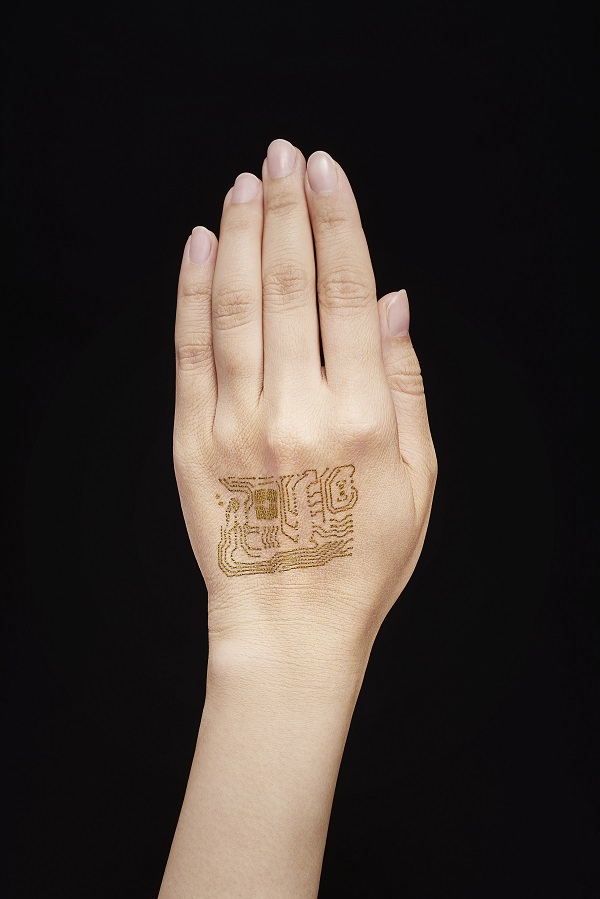Breathable, wearable electronics on skin for long-term health monitoring New nanomesh structure lets skin breathe, prevents inflammation Research news


Nanomesh conductor applied to back of hand
The nanomesh electrode closely follows the contours of the back of the hand for a perfect fit when attached to the skin. The stretchable device lets the skin breathe naturally, and is so thin and light that wearers forget they even have it on.
© 2018 Someya Laboratory.
A hypoallergenic electronic sensor can be worn on the skin continuously for a week without discomfort, and is so light and thin that users forget they even have it on, says a group of researchers at the University of Tokyo and their collaborators. The elastic electrode constructed of breathable nanoscale meshes holds promise for the development of noninvasive e-skin devices that can monitor a person's health continuously over a long period.
Wearable electronics that monitor heart rate and other vital health signals have made headway in recent years, with next-generation gadgets employing lightweight, highly elastic materials attached directly onto the skin for more sensitive, precise measurements. However, although the ultrathin films and rubber sheets used in these devices adhere and conform well to the skin, their lack of breathability is deemed unsafe for long-term use: dermatological tests show the fine, stretchable materials prevent sweating and block airflow around the skin, causing irritation and inflammation, which ultimately could lead to lasting physiological and psychological effects.
"We learned that devices that can be worn for a week or longer for continuous monitoring were needed for practical use in medical and sports applications," says Professor Takao Someya at the University of Tokyo's Graduate School of Engineering whose research group had previously developed an on-skin patch that measured oxygen in blood.
In the current research, the group developed an electrode constructed from nanoscale meshes containing a water-soluble polymer, polyvinyl alcohol (PVA), and a gold layer—materials considered safe and biologically compatible with the body. The device can be applied by spraying a tiny amount of water, which dissolves the PVA nanofibers and allows it to stick easily to the skin—it conformed seamlessly to curvilinear surfaces of human skin, such as sweat pores and the ridges of an index finger's fingerprint pattern.
The researchers next conducted a skin patch test—for irritations and skin allergies—on 20 subjects and detected no inflammation on the participants' skin after they had worn the device for a week. The group also evaluated the permeability, with water vapor, of the nanomesh conductor—along with those of other substrates like ultrathin plastic foil and a thin rubber sheet—and found that its porous mesh structure exhibited superior gas permeability compared to that of the other materials.
Furthermore, the scientists proved the device's mechanical durability through repeated bending and stretching, exceeding 10,000 times, of a conductor attached on the forefinger; they also established its reliability as an electrode for electromyogram recordings when its readings of the electrical activity of muscles were comparable to those obtained through conventional gel electrodes.
"It will become possible to monitor patients' vital signs without causing any stress or discomfort," says Someya about the future implications of the team's research. In addition to nursing care and medical applications, the new device promises to enable continuous, precise monitoring of athletes' physiological signals and bodily motion without impeding their training or performance.
Paper
, "Inflammation-free, gas-permeable, lightweight, stretchable on-skin electronics with nanomeshes", Nature Nanotechnology Online Edition: 2017/07/18 (Japan time), doi: 10.1038/nnano.2017.125.
Article link (Publication)
Links
Graduate School of Engineering
Department of Electrical Engineering and Information Systems, Graduate School of Engineering






